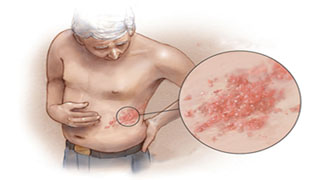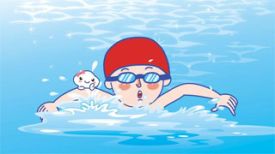
Herpes zoster, also known as "wrapped waist fire pill" in traditional Chinese medicine, is commonly referred to as "snake pill ulcer", "spider ulcer", and "wrapped waist dragon" in folk customs. This disease is often caused by emotional instability and eating disorders, resulting in spleen dysfunction, stagnation of dampness and turbidity, depression leading to heat, damp heat stagnation, and susceptibility to toxic pathogens.
Causes and symptoms of herpes zoster
Herpes zoster is often caused by excessive heat in the heart meridian, damp heat in the spleen and lungs, and excessive heat in the liver and gallbladder. It is a common herpetic skin disease in clinical practice, caused by chickenpox and herpes zoster virus. Clinically, there are often several clustered herpes clusters arranged in a band like pattern, distributed along the peripheral nerves, often unilateral, generally not exceeding the midline of the body surface, and often irregularly distributed in a band like pattern. They are commonly found in the chest, abdomen, waist, back, and face, with local skin burning sensation and accompanied by neuropathic pain.
Western medicine considers it to be a viral infection, and there is currently no specific treatment available. The initial infection of the virus can lurk in the posterior root ganglia of the spinal cord for a long time, grow and reproduce, spread along the peripheral nerves to the skin, and cause herpes zoster.
Its clinical manifestation will be clustered blisters, distributed in a clustered band along one side of the peripheral nerve, accompanied by severe neuropathic pain. Once herpes zoster is misdiagnosed, lost to treatment, and the patient's own immune system is weakened, it can lead to clinically difficult sequelae - postherpetic neuralgia.
Dialectical treatment of herpes zoster with traditional Chinese medicine
The diagnosis and treatment of herpes zoster can be divided into three types: heat excess type, dampness excess type, and qi stagnation and blood stasis type.
1. Hot type
【 Main symptoms 】 Local skin lesions are bright red, with tight blister walls and burning and stinging sensations. Self aware of bitter mouth, dry throat, thirst, irritability, and poor appetite. Urine is red, stool is dry or uncomfortable. The tongue is red in color, the tongue coating is thin yellow or thick yellow, and the veins are slightly smooth.
Dialectically, liver and gallbladder are hot, qi stagnation and dampness obstruction, and also susceptible to toxic and pathogenic factors.
【 Treatment 】 Clearing heat and dampness, detoxifying and relieving pain.
[Prescription] Modified Longdan Xiegan Tang.
2. Wet forming
【 Main symptoms 】 The skin color is light, the blister wall is loose, the pain is slightly mild, the mouth is not thirsty or thirsty but does not want to drink, does not think about food, bloats after eating, and the bowel movements are short-lived. Female patients often have more vaginal discharge. The tongue is light in texture and the body is plump. The tongue coating is white, thick, or greasy, and the pulse is deep, slow, or smooth.
Dialectically, the spleen loses its vitality, dampness cannot be dissipated, and it is also susceptible to toxins and evil.
【 Treatment 】 Strengthen the spleen and eliminate dampness, accompanied by detoxification.
[Prescription] Modified Dehumidification Weiling Decoction.
3. Qi stagnation and blood stasis type
【 Main symptom 】 After the rash subsides, local pain persists. The tongue is dark, the coating is white, and the veins are fine. Dialectical analysis: Qi stagnation and blood stasis, promoting qi circulation to relieve pain, clearing heat and residual toxins.
【 Prescription 】 Huoxue San Yu Tang modified.
Comprehensive internal and external treatment methods of traditional Chinese and Western medicine for herpes zoster
There are many treatment methods introduced in clinical practice, but there are not many with specific effects. Oral prescriptions such as "Longdan Xiegan Tang" are often recommended for treatment. When I first learned medicine, I also applied them several times, but the effect was not ideal. For the treatment of this disease, modern Western medicine commonly uses drugs such as acyclovir, ribavirin, ibuprofen, and vitamins, but the efficacy is not ideal. Traditional Chinese medicine has rich treatment methods and good clinical efficacy for this disease.
Later, it was discovered that this formula was actually the Erwei Ba Du San from the surgical section of the "Golden Mirror of the Medical School". Erwei Ba Du San comes from the "Golden Mirror of the Medical School", which consists of two herbs: realgar and alum. The "Golden Mirror" states that this powder is very effective in treating rheumatism, various sores, redness, swelling, pain, itching, scabies, and other diseases. When dipped in goose feathers and swept around the affected area, the pain and itching will stop and the redness and swelling will disappear. But it did not mention the treatment of herpes zoster (Raoyao Huodan). Since I obtained this prescription, it has been applied dialectically and flexibly, and has been repeatedly used in clinical practice with remarkable results.
Method 1: Simple formula for herpes zoster
Firstly, take oral antiviral drugs and B vitamins.
Secondly, locate the snake head and tail of the herpes, select and treat them. Use a needle to break through all the herpes and remove the bleeding water, then apply moxibustion. Finally, clean up the external application of Niuhuang Jiedu or Xihuang Wan and other medicinal powders, which can be effective or cured in one go.
Method 2: "Herpes zoster" special prescription
15 grams of realgar, 15 grams of indigo, 10 grams of dried alum, and 6 grams of borneol.
Method: Grind the medicine into fine powder and prepare it for later use. Squeeze a tube of acyclovir cream into a container and mix well. Apply foam to the affected area. The next day, the pain will greatly decrease, and the foam will completely disappear and scab after 2-3 days. You can recover without taking medicine or injections!
Solution: Herpes zoster is called "snake string ulcer" in traditional Chinese medicine, and its symptoms include redness, swelling, heat, pain, and dampness. The basic pathogenesis is the retention of damp heat and pathogenic toxins in the meridians and skin. The treatment uses realgar to drive away snakes, indigo and Dahan to clear heat and detoxify, and dried alum and dry dampness as the two main medicines to achieve the function of clearing heat, detoxifying, and drying dampness. Borneol cold and cool can also clear heat and relieve pain, and can help various medicines penetrate the skin as an adjuvant. Acyclovir cream is used as an excipient.
Method 3: Postherpetic sequelae of herpes zoster
Grind 10 grams of antelope horn, 3 grams of artificial bezoar, 3 pills of Liu Shen Wan, 10 grams of perennial youth, 10 grams of lotus root, 10 grams of summer grass, 10 grams of long worm grass, 6 grams of whole worm, 10 grams of rhubarb, 30 grams of Huanglian, 10 grams of Kochia scoparia, 15 grams of indigo, and 25 grams of Sophora flavescens for later use.
When using, take 15 grams and mix them with poly muscle cell needle and safflower needle. Add 22 tablets of anti-inflammatory pain and apply them to the Ashi acupoint, Shenque, and Kidney Transfusion. Before use, use a seven star needle to puncture and then bake with an infrared lamp before applying.
Method 4: acupuncture and moxibustion treatment
characteristic:
On the one hand, it can eliminate blisters and erythema, and on the other hand, it can prevent neuralgia left after the disappearance of herpes zoster, and can shorten the course of treatment and adverse side effects. Acupuncture and moxibustion has a rapid analgesic effect on herpes zoster, and can enhance the resistance of the human body.
Generally speaking, the prognosis of herpes zoster is good. acupuncture and moxibustion can be used alone and the effect is very good. Generally, after 1-3 times of acupuncture and moxibustion treatment, there will be significant improvement.
Acupoint selection strategy
The relationship between the Jiaji acupoint of the corresponding ganglion segment, Huatuo Jiaji acupoint, and the distribution of spinal nerve stages: Spinal nerve refers to the peripheral nerves connected to the spine, mainly distributed in the trunk and limbs, with a total of 31 pairs, connected to the spinal cord in the anterior and posterior heels.
Both the front and rear heels are composed of many nerve fibers, with the front heel being sporty and the rear heel being sensory. There are a total of 31 pairs of spinal nerves, including 8 pairs of cervical nerves, 12 pairs of thoracic nerves, 5 pairs of lumbar nerves, 5 pairs of sacral nerves, and 1 pair of caudal nerves.
Pattern of acupoint selection
Symptomatically add acupoints, prescription example: a. Local acupuncture points, plus Waiguan, Quchi, Sanyinjiao, and Taichong. b. Herpes on the head and face, combined with the valley and inner courtyard. c. For those with herpes above the waist, add branch grooves and internal barriers. d. For those with herpes below the waist, add Blood Sea and Yin Ling Spring.
1. Locally subcutaneous (Ashi acupoint) or adjacent acupoints (i.e. surrounding needle acupoint).
2. The nerve root (i.e. Jiaji acupoint) used to repair the lesion in the back.
3. Remote acupoint selection (Quchi, Hegu, Zusanli, Sanyinjiao, Shenzhu, Neiguan, Yanglingquan).
Technique:
The approach for selecting acupoints is to locally surround and puncture the corresponding spinal acupoints of the ganglion, and select acupoints along the meridian.
Method: To confirm acute pain, use the method of lifting, inserting, twisting, and switching to the method of releasing. Leave a needle for 20 to 30 times twice a day, and use a filiform needle to puncture the local area horizontally. Acute symptoms can still be treated with acupoint bloodletting, once every other day. Or use a skin needle or a plum blossom needle to lightly prick around the herpes.
Postnatal neuralgia:
Local acupoint selection at the affected area: 1. Stab around the blister (i.e. use five needles horizontally at 0.5-1.0 inches around the blister). When applying the needle, the needle tip should be inserted horizontally at a 10-30 degree angle towards the central area of the herpes.
Method 5: Acupuncture and Knife Treatment
(1) Using the needle knife medical imaging reading method, X-ray images of the corresponding innervation segments of the spine are read. For example, if the disease occurs along the 5th and 6th rib nerves, observe the 5th and 6th thoracic vertebrae. If the disease occurs on the lateral side of the thigh, observe whether there is bone and joint displacement in the 2nd and 3rd lumbar vertebrae. If there is displacement, take the affected vertebral body spinous process as the center, mark a point at the midpoint of the line connecting the upper and lower vertebral body spinous processes, and open 2-2.5cm next to these two points, with four points each, for a total of six points. When the two middle knives are inserted, the cutting edge line is parallel to the longitudinal axis of the spine, and the needle body is perpendicular to the skin plane of the injection site. Insert it 3-5mm outside the spinal canal, and then turn the cutting edge line 90 °. Use the method of incision and dissection to cut open the ligament, making 2-3 incisions, and be careful not to enter the spinal canal. Next to the four needles, the cutting edge line is parallel to the longitudinal axis of the spine, and the needle body is inserted perpendicular to the skin plane of the injection site, reaching a depth of the rib transverse process bone surface. Then carefully move the needle knife to the rib transverse process joint, slightly rotate the cutting edge line, and cut the rib transverse process joint capsule 2-3 times. If the lumbar spine is displaced, the needle knife should reach the posterior articular process bone surface and cut the posterior articular capsule 2-3 times.
(2) If tenderness, nodules, or cord like changes can be felt within the spinal zone, the patient should be placed in a prone position. Several points should be set at the tender point, nodule, or cord, and a needle knife should be inserted at these points. The cutting line should be parallel to the human body, and the longitudinal axis should be parallel to the depth of the rib transverse process joint surface or the posterior articular bone surface of the lumbar spine. If the depth between the spinous processes is more than 3 mm outside the spinal canal, after the needle knife reaches the corresponding depth at each point, the painful point can be longitudinally or transversely dissected. If there are nodules and cords, longitudinal incision or scar scraping should be performed.
(3) After examination, if there is no corresponding displacement of the vertebral body or pain in the spinal zone, and there are nodules and cord like changes, it is simply caused by electrophysiological circuit disorders. The treatment method is:
When the elbow is bent 90 degrees on the radial side of the upper limb, at the end of the transverse crease of the elbow, a point is set on the affected side, the cutting edge line is parallel to the longitudinal axis of the radius, the needle body is perpendicular to the skin plane of the needle insertion site, and the needle is inserted 1cm, horizontally peeled off 2-3 times, and the speed should be fast.
Between the first and second metacarpal bones on the back of the hand, at the midpoint of the second metacarpal bone, a point is set on the affected side. The cutting edge line is parallel to the longitudinal axis of the second metacarpal bone, and the needle body is perpendicular to the skin plane of the needle insertion site. Insert 1cm horizontally and peel off 2-3 times, preferably at a fast speed.
Two inches above the patella, at the location of the affected lower limb, the incision line is parallel to the longitudinal axis of the lower limb, and the needle body is perpendicular to the skin plane of the needle insertion site. The needle is inserted 2cm and horizontally peeled off 2-3 times, preferably at a fast speed.
Located in the center of the transverse crease of the popliteal fossa, a point is set at the affected area, with the incision line parallel to the longitudinal axis of the lower limb, and the needle body perpendicular to the skin plane of the needle insertion site. The needle is inserted 1cm and horizontally peeled off 2-3 times, with a recommended speed.
Method 6: Acute phase treatment
Acute phase method 1: External application of fresh purslane to treat herpes zoster: Take 120 grams of fresh tartar, wash it, chop it up and put it in garlic white, mash it into a paste, apply it to the affected area twice a day. This formula has satisfactory therapeutic effect on newly appeared herpes zoster.
Acute phase method 2: External use of medication, external use of earthworm to treat herpes zoster. Take an appropriate amount of earthworm, dry and grind it into powder, add an appropriate amount of sesame oil and apply it to the affected area. Generally, taking the medicine for 5 minutes can relieve pain. Recovered in 3-4 days.
matters needing attention:
During the treatment period, it is not advisable to consume spicy foods or foods that can cause allergies, such as fish, shrimp, and crabs. You should rest in bed, pay attention to nutrition, and wear clean and soft cotton underwear to reduce friction. If the pain affects sleep, you can take some sedatives and painkillers appropriately. Elderly and physically weak individuals should try to avoid going to public places with unclean air as much as possible to prevent infection. Exercise regularly, maintain a happy mood, and have a regular lifestyle.
Do I still need to take painkillers after treating herpes zoster neuralgia?
For the treatment of herpes zoster neuralgia with nerve block, in order to avoid needle eye infection at the injection site, it is best not to touch water or take a shower within 48 hours; In addition, keep the skin in the area with long blisters on the rash dry, try not to break it, and do not apply topical medications on your own. After injection therapy, it is generally not a problem to bend down and lie down. Rest should be the main focus, do not work too hard, and do not exercise. Wait for the rash on the skin to scab and fully recover before exercising.
Some people feel a little dizzy after taking the medicine, usually they just need to rest for a while. Due to the fact that the treatment site is determined through accurate evaluation, and the treatment is only targeted at the local nerves, the possibility of damaging other surrounding nerve tissues is very small.
In addition, while undergoing local treatment, in order to ensure effective pain relief, patients need to use painkillers such as carbamazepine and gabapentin in combination. These painkillers generally do not cause drug dependence and there is no need to worry about addiction. Moreover, painkillers must be taken according to medical advice. They should not be taken when they are painful or when they are not, otherwise the pain relief effect will be poor. If after taking painkillers for a certain period of time, the pain relief effect is better and the pain is no longer felt, then you can consider stopping the medication. Usually, the dosage is gradually reduced, and once it is reduced to a very small amount and there is no pain, the medication can be completely stopped. If the effect of taking painkillers is not good, it means that the patient is not sensitive to these types of painkillers and needs to switch to other pain relief methods.


